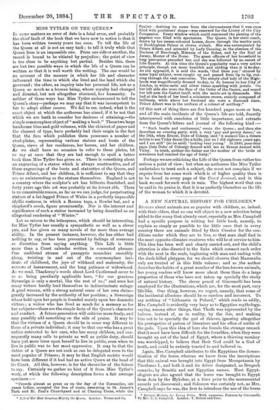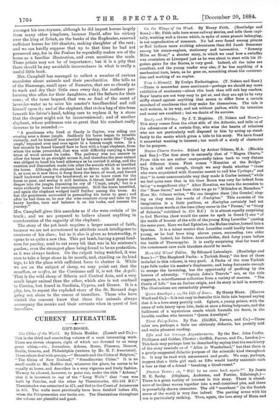A NEW NATURAL HISTORY FOR CHILDREN.* STORIES about animals are
so popular with children, as, indeed., with their elders, that no one will object to a new selection being added to the many that already exist, especially as Mrs. Campbell had a specific purpose in writing her little book, namely, to. explain as simply as possible to the little ones that in every country there are animals fitted by their Creator for the con- ditions under which they are to live, so that man shall find in. the most opposite climates creatures who will be of service to him. This idea has been well and clearly carried.out, and the child's attention is also directed to the links which connect each order with the next in the scale, beginning with man and ending with the duck-billed platypus, for we should observe that Mammali& only are treated of in this little volume ; and as :the author describes the habits of a great number of the less-known animals, her young readers will know more about them than do a large proportion of those who have not taken up specially the study of natural history. The clever pencil of Giacomelli has been employed for the illustrations, which are, for the most part, very life-like. One thing, however, we regret, namely, that some of' the incidental allusions should be so careless and incorrect. To say nothing of "Lithuania in Poland," which reads so oddly,. Mrs. Campbell is evidently very hazy as to Egyptian mythology, saying, among other things, that Thoth was represented by the baboon, instead of, as in reality, by the ibis, and making him out to be specially the god of thieves, ignoring altogether his prerogative of patron of literature and his office of scribe of the gods. Upon this idea of hers she founds the strange remark that it must have been difficult for the Israelites, when they were brought up out of the land of Egypt, where a thieving monkey was worshipped, to believe that their God could be a God of' truth, and could be entirely trusted to and believed in.
Again, Mrs. Campbell attributes to the Egyptians the domes- tication of the horse, whereas we know from the inscriptions that this animal was brought into Egypt from Mesopotamia by Thothmes I., and both it and its driver designated, as Brugach remarks, by Semitic and not Egyptian names. Most Egypt- ologists are also agreed that the horse was brought to Egypt from Asia by the Hykshos, at a time prior to the monumental records yet discovered ; and Solomon was certainly not, as Mrs. Campbell says he was, the first to introduce the use of the horse
• Natural History for Young Folks. With numerous Pictures by Giacomelli. By Mrs. C. C. Campbell. London : T. Nelson and Sono.
amongst his couLtrymen, although he did import horses largely from many other kingdoms, because David, after his victory over the king of Zobah, on the banks of the Euphrates, reserved sufficient horses for 100 chariots, making slaughter of the rest; and we can hardly suppose that up to that time he had not possessed any, for in the Psalms he repeatedly makes use of the horse as a familiar illustration, and even mentions the mule. These points may not be of importance; but it is a pity that
-there should be any avoidable incorrectness in what is really a useful little book.
Mrs. Campbell has managed to collect a number of curious -anecdotes about animals and their peculiarities. She tells us of the Siamangs, small apes of Sumatra, that are so cleanly as • to wash and dry their little ones every day, the mothers per- forming this office for their daughters, and the fathers for their • sons ; of the tame leopard, that was so fond of the scent of lavender.water as to seize his master's handkerchief and roll • himself upon it; and of the elephant, that stole a bag of rice from beneath his driver's head, taking care to replace it by a stone that the sleeper might not be inconvenienced ; and of another • elephant, whose politeness was so great that his conduct really -deserves to be recorded :—
" A gentleman who lived at Candy in Ceylon, was riding one • evening near a dense jungle. Suddenly his horse began to tremble violently, and he himself was startled by hearing a noise like 'Umph, umph,' repeated over and over again in a hoarse rough voice. In a Tew seconds he found himself face to face with a huge elephant, from -whom the noise proceeded, that was with difficulty carrying a large ' beam of wood across its tusks. The pathway was too narrow to allow the beam to go straight across it, and therefore the poor animal was obliged to bend his head sideways as he carried it along, and the
• exertion and discomfort made him utter the sounds which so terrified the horse. Although the elephant had no driver with it to instruct it, as soon as it saw them it flung down the beam of wood, and forced itself backward among the brushwood, so as to leave room for the 'horse to pass, and seeing it still hesitate, it thrust itself deeper and -deeper into the jungle, repeating its cry of Cf mph, umph,' but in a voice evidently meant for encouragement. Still the horse trembled, and again the elephant wedged itself further among the trees. At last the gentleman succeeded in persuading his horse to pass ; and after he had done so, he saw the wise creature stoop and take up his heavy burden, tarn and balance it on his tusks, and resume his journey."
Mrs. Campbell gives this anecdote as if she were certain of its truth; and we are prepared to believe almost anything in corroboration of the sagacity of the elephant.
The story of the pet lamb requires a larger amount of faith, because we are not accustomed to attribute much intelligence to creatures of his class ; but as it also is given as trustworthy, it opens tons quite a new ilea. This pet lamb, having a great fond- ness for parsley, used to eat every bit that was in his mistress's ,garden; even the strongest glass being found to be no protection, as it was always broken. On the culprit being watched, it was seen to take a large stone in its mouth, and, standing on its hind legs, to hit the glass with sufficient force to shatter it. While we are on the subject of sheep, we may point out that the mouffion, or muffro, as the Corsicans call it, is not the Argali.
That is the wild sheep of Siberia and Central Asia, and a very much larger animal than the other, which also is not confined -to Corsica, but found in Sardinia, Cyprus, and Greece. It is a pity, too, to repeat the exploded story of the St. Bernard dogs going out alone to the rescue of travellers. Those who have
visited the convent know that these fine animals always accompany the monks and their servants when in quest of lost travellers.







































 Previous page
Previous page